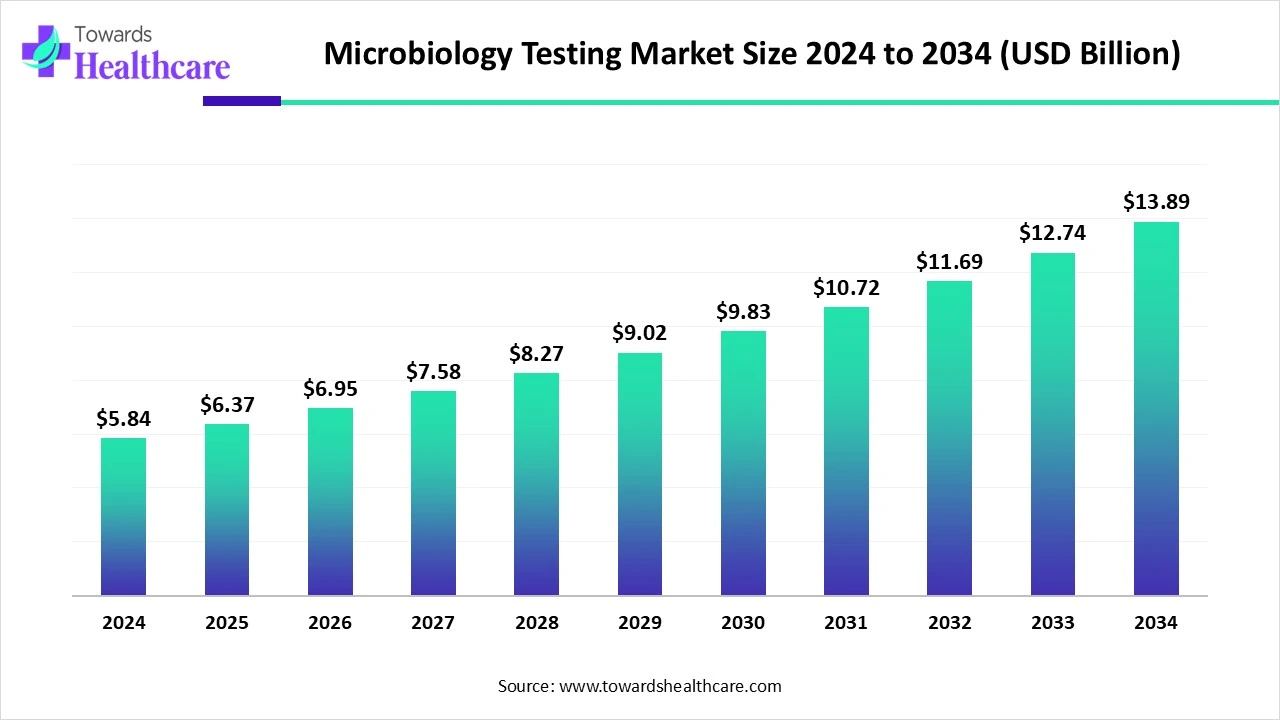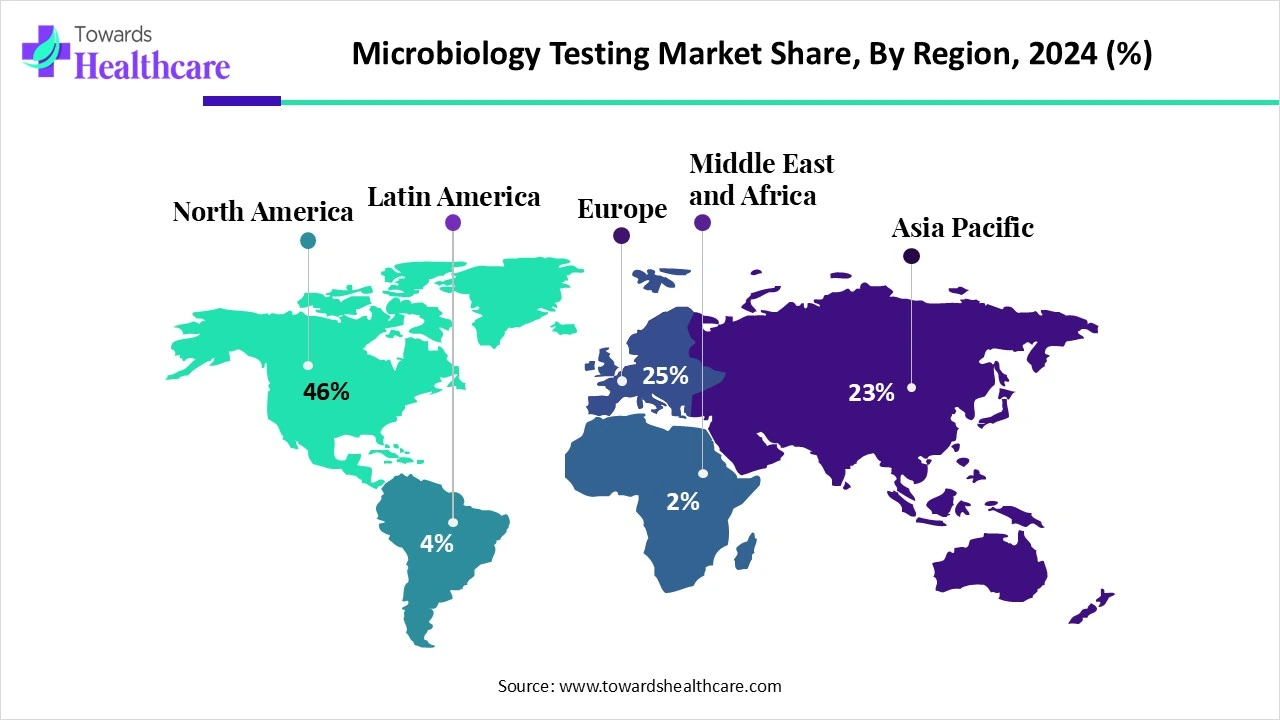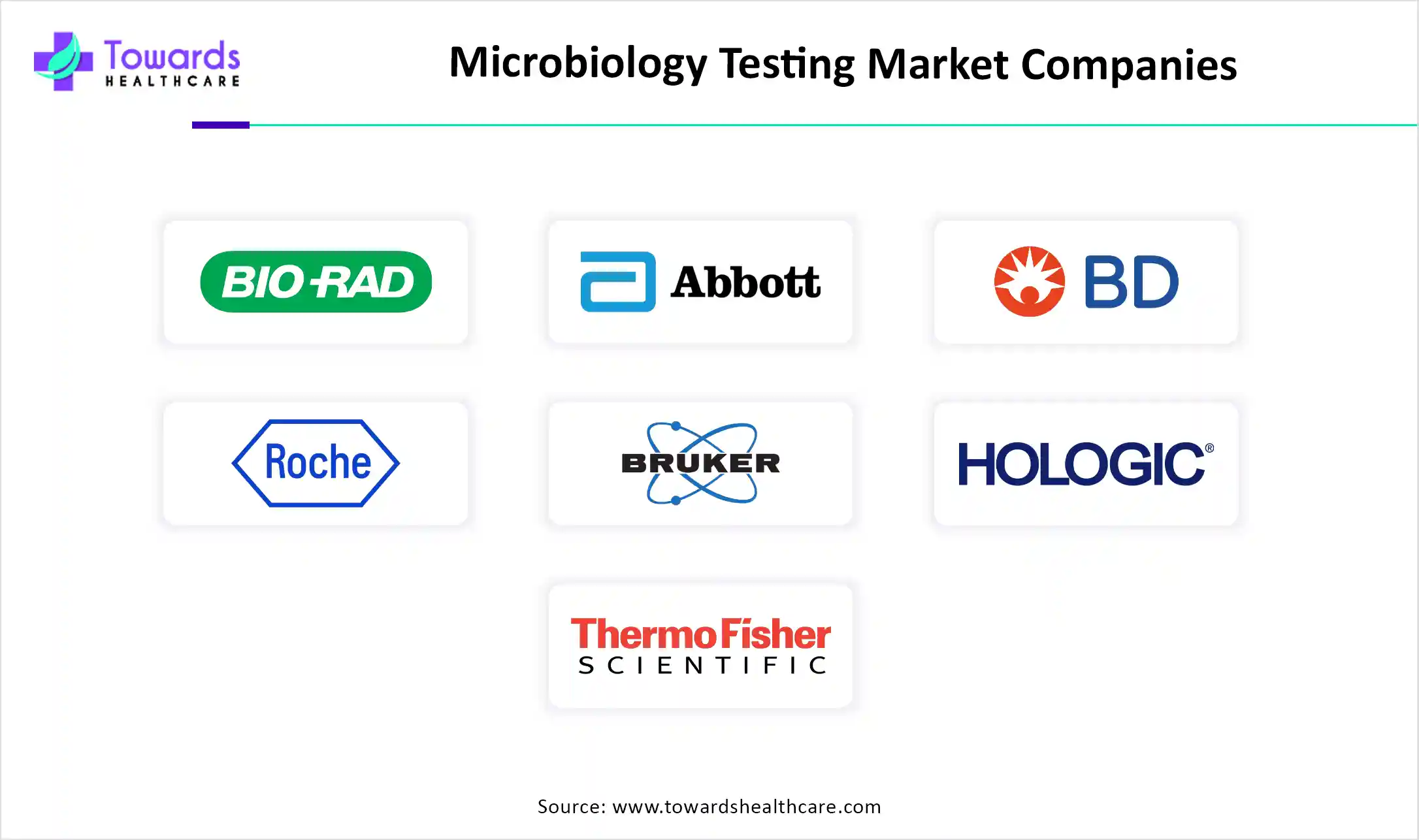November 2025

The global microbiology testing market size is calculated at USD 5.84 in 2024, grew to USD 6.37 billion in 2025, and is projected to reach around USD 13.89 billion by 2034. The market is expanding at a CAGR of 9.04% between 2025 and 2034.

| Metric | Details |
| Market Size in 2025 | USD 6.37 Billion |
| Projected Market Size in 2034 | USD 13.89 Billion |
| CAGR (2025 - 2034) | 9.04% |
| Leading Region | North America market share by 46% |
| Market Segmentation | By Product, By Test Type, By Application, By End User, By Region |
| Top Key Players | Bio-Rad Laboratories Inc., Abbott Laboratories, Becton Dickinson and Company, F. Hoffmann-La Roche Ltd, Bruker Corporation, Hologic Corporation, Danaher Corporation (Cepheid Inc.), Biomerieux SA, Thermo Fisher Scientific Inc., Agilent Technologies Inc., Merck KGaA, Shimadzu Corporation, NEOGEN Corporation |
Microbiology testing is an essential branch of research that looks for microorganisms such as parasites, fungi, viruses, and bacteria. These tiny organisms have the potential to have a big influence on the environment, industry, and human health. The discovery of effective antibiotic medicines and the management of resistance are facilitated by an understanding of the importance of microbiological testing. Patient health, company reputation, and regulatory compliance in the pharmaceutical and medical device industries are all seriously threatened by microbial contamination. Microbiology testing is necessary to make sure that items are devoid of harmful germs, lessen these risks, and meet stringent regulatory criteria.
Diagnosis is important for medical therapy, and it is essential to identify the microorganisms that cause infections and diseases. The application of artificial intelligence (AI) systems in microbiological diagnostics can improve disease management, drug development, antibiotic resistance prediction, and epidemiological monitoring. Because AI systems can quickly and accurately detect infections, including new and drug-resistant forms, they provide early detection of antibiotic resistance and improved diagnostic techniques. The primary objectives of using AI in bacterial diagnostics are to identify infections quickly, accurately, and accurately as well as to predict treatment resistance.
Rising Importance & Awareness of Food Safety
The WHO estimates that each year, 600 million people become unwell and 420,000 pass away as a result of consuming tainted food, costing 33 million years of good life. The need for microbiological testing is rising as people become more conscious about food safety and cleanliness. To make sure that food items and other consumables are safe to eat, these tests are utilized to find any dangerous microbes in them.
Lack of Skilled Workers
Because harmful bacteria must be managed, clinical microbiology necessitates a team that is competent and well-trained. The high-tech and difficult-to-use test equipment is said to be impeding the expansion for microbiology testing market. The market's demand is also being hampered by the increase in real-time technological problems.
Technological Advancements & Expanding Applications
As technological developments continue to improve testing capabilities and expand application areas, there are several opportunities in the market for quick microbiological testing. There is a lot of room for expansion given the growing need for rapid and precise testing solutions in sectors including environmental monitoring, pharmaceuticals, and food and beverage. Furthermore, the advent of cutting-edge testing techniques like biosensors and molecular diagnostics creates opportunities for new goods and services. Rapid testing is also becoming more popular due to growing awareness of infectious illnesses, food safety, and antibiotic resistance, which may be profitable.
By product, the instruments segment dominated the microbiology testing market in 2024. The segmental growth is attributed to the growing need for testing and increasing funding for adopting advanced instruments in a lab. There are many different types of instruments used in the microbiology labs, which are necessary for the many operations carried out there. To aid in the research and analysis of microorganisms, they are furnished with specialized equipment, including spectrophotometers, centrifuges, autoclaves, incubators, PCR machines, and microscopes, among others.
By product, the reagents segment is anticipated to be the fastest-growing in the microbiology testing market during 2025-2034. Materials called microbiology reagents are used in microbiological investigations to classify, identify, and examine microorganisms like bacteria. Among the many industries that rely on these substances are research, environmental monitoring, and medical diagnostics. Reagents are used to test bacteria in order to identify certain species, regulate the development of germs, and assess antibiotic sensitivity.
By test type, the bacterial segment held the major share of the microbiology testing market in 2024. This segment dominated because bacteria may have a significant influence on people; it is crucial to identify them using biochemical assays. Being able to accurately identify bacteria can be essential to preserving human health since certain kinds of bacteria are beneficial while others are hazardous. Accurately identifying bacteria is crucial for deciding what to do next after they are found in fields ranging from the food business to medicine.
By test type, the viral segment is expected to grow at a significant rate in the microbiology testing market during the predicted timeframe. By identifying the presence of viruses in the body through the examination of materials like blood or saliva, viral testing is a crucial diagnostic process that aids in the early detection of viral infections. In order to stop the spread of infectious diseases, viral testing, which makes use of methods like PCR (polymerase chain reaction), provides accurate and timely results. Knowing about these tests makes it simpler to prevent and cure diseases like the flu and emerging viruses like COVID-19.
By application, the gastrointestinal segment held the majority of shares of the microbiology testing market in 2024. The global burden of gastrointestinal (GI) diseases is the result of the interaction of incidence, severity, and duration. Understanding this burden is necessary to address the threat GI infections pose to public health and to allocate resources and efforts effectively. Numerous diagnostic methods can be used to identify intestinal infections. These include stool or fecal tests that look for parasites, germs, or viruses in the bowel movement, as well as blood testing.
By application, the respiratory diseases segment is anticipated to grow at the fastest CAGR in the microbiology testing market during the forecast period. Clinical microbiology and respiratory diseases are two intricately linked fields of medicine that are essential to comprehending and stopping the transmission of diseases brought on by microbes. Medical professionals who are specialized in the diagnosis, treatment, and prevention of respiratory illnesses depend on various microbiology testing throughout the process. They may also be engaged in the study and creation of novel anti-infection medications and vaccines.
By end-user, the hospitals segment held the largest revenue share of the microbiology testing market in 2024. Hospital and service labs are essential to global public health, particularly as diagnostics account for 60–70% of medical decisions. Hospital microbiology services are essential for the diagnosis and treatment of many infectious disorders. These services are essential to hospitals because they empower medical staff to make well-informed decisions on infection prevention, patient care, and public health initiatives.
By end-user, the academic and research institutes segment is anticipated to grow at a significant CAGR in the microbiology testing market over the predicted period. Knowledge of the epidemiology of different bacteria is a major goal of microbiological research labs worldwide. The food, veterinary, pharmaceutical, and environmental sectors, as well as clinical researchers, depend on accurate and quick microbial identification to monitor the pathogenicity, virulence, and antibiotic resistance of strains and subspecies in the population.

North America dominated the microbiology testing market share by 46% in 2024. A few of the factors propelling the North American market's expansion are improved healthcare infrastructure, the increasing prevalence of infectious diseases and epidemics, technological developments in microbiology testing, and the existence of major market participants in the nation. Additionally, the market is expanding due to the region's increasing frequency of infectious illnesses. In order to get a larger portion of the market, the companies are implementing a number of tactics, including product launches, innovations, acquisitions, alliances, and expansions.
The U.S. aggressively seeks to prevent, identify, and address infectious disease concerns in order to safeguard the American people. The U.S. Department of State's Bureau of Global Health Security and Diplomacy (GHSD) is in charge of organizing and directing the Department's efforts to improve global health security in order to stop, identify, and treat infectious illnesses, such as HIV/AIDS. In order to better safeguard the U.S. and the rest of the world against health hazards, the Bureau leads U.S. diplomatic engagement, coordinates and leverages U.S. foreign aid, and fosters international collaboration at the national, regional, and multilateral levels. As a fundamental element of U.S. foreign and national security strategy, the Bureau integrates and elevates global health security.
Enteric infections affect millions of Canadians annually, and many of them are brought on by or connected to travel abroad. A parallel shift in the incidence of travel-acquired enteric infections is anticipated as the number of Canadians who travel varies throughout the year. In order to improve point-of-care HIV and other STBBI testing accessibility for Indigenous Peoples residing in rural and remote areas, Canada's National Microbiology Laboratory works with regional and federal partners. Off-reserve Indigenous-led STBBI initiatives are also eligible for special financing from Canada. To increase access to HIV self-testing, Canada allocated $26.5 million in time-limited financing in 2022–2024. Among these was $16.6 million to help fund the acquisition of HIV self-test kits and the development of training, educational, and promotional materials for critical groups and community-based organizations.
Asia Pacific is estimated to host the fastest-growing microbiology testing market during the forecast period. Driven by the population's growth, the expansion of healthcare facilities, and the development of infectious illnesses. The governments of China, India, and Japan are investing heavily in public health programs and healthcare modernization in order to provide quick diagnostic instruments. The market is expanding as a result of a significant emphasis on food safety and quality control in foods and drinks. Rapid microbiological testing is also used by significant biotechnology and pharmaceutical firms in the area to improve product development and adhere to international regulatory norms. These technologies are also made possible by more local companies and cost-effective manufacturers, which raises the market's potential for growth.
By 2030, China aims to bring the country's capacity to identify early indicators of an epidemic and issue timely warnings to a level that leads the world in infectious disease monitoring and early warning systems. Additionally, more will be done to create a network of laboratories to test and track the spread of harmful germs, coordinate monitoring across various government agencies, and utilize public and media reporting.
CDC has more than 50 years of experience in India. The Ministry of Health and Family Welfare, CDC India, and partner organizations collaborate closely to identify, stop, and manage infectious disease outbreaks as well as to develop and enhance the nation's fundamental public health skills. Data and surveillance, laboratory capacity, personnel and institutions, prevention and response, research and innovation, policy, communications, and diplomacy are some of these. CDC works to safeguard public health globally and the health of our countries.
Europe is expected to grow significantly in the microbiology testing market during the forecast period. First, Europe boasts a sophisticated healthcare system with cutting-edge research facilities and labs. Strict regulations pertaining to food safety, the environment, and healthcare encourage the use of cutting-edge microbiological testing tools. Additionally, Europe's aging population is more prone to illnesses, which makes diagnostic services more desirable. Antibiotic-resistant germs are becoming more common, which increases demand as laboratories and hospitals place a higher priority on quick, precise diagnosis.
As part of the "DART 2030" German Antibiotic Resistance Strategy, Germany is combining efforts to prevent antibiotic resistance. The only way to effectively combat antibiotic resistance in the long run is through worldwide cross-sectoral collaboration in agriculture, veterinary medicine, and human medicine. Antibiotic resistance is a problem Germany frequently discusses when leading the G7 and G20.
With a series of five-year National Action Plans (NAPs), the UK has a 20-year plan to combat AMR. The goal is to unite government agencies to limit, control, and reduce AMR by 2040. The revised strategy will bind the UK to limiting the overuse of antibiotics in both humans and animals, enhancing the monitoring of illnesses resistant to drugs, and encouraging business to create the next generation of therapies.
Latin America is expected to account for a significant revenue share of the microbiology testing market in 2024. The growing demand for diagnostics, increasing prevalence of infectious disorders, and the rising geriatric population are the major growth factors of the market in Latin America. The increasing adoption of advanced technologies leads to the development of novel diagnostics. The rising healthcare expenditure and increasing investments and collaborations among key players contribute to market growth.
Key players, such as SGS SA, Mérieux NutriSciences, and Intertek, offer state-of-the-art microbiology testing services in Mexico. The World Bank Group reported 23 TB cases per 100,000 population in Mexico in 2023. (Source: Wold Bank Group)
According to the global HBC lists for 2021-2025, Brazil is listed in two of the three lists of TB-burden countries. It is listed in the TB list and the HIV-associated TB list. The prevalence of TB in Brazil is more than 150 per 100,000 population annually. (Source: WHO)
The Middle East & Africa are expected to grow at a notable CAGR in the microbiology testing market in the foreseeable future. The increasing number of testing laboratories and the need for safer products boost the market. The rising prevalence of infectious disorders and advancements in technology augment market growth. The presence of key players and increasing collaborations among them facilitates microbiology testing. The growing demand for point-of-care testing and advancements in diagnostic technologies propel the market.
Fungal diseases are estimated to affect approximately 2.46% of the total population in the UAE. In June 2024, Smart Salem launched an AI-powered metagenomic whole-genome shotgun sequencing test to provide a comprehensive insight into overall health. The test provides information about microbial diversity, digestive potential, microbial metabolites, and eukaryotic microorganisms.
The WHO reported that there were an estimated 280,000 people infected with TB in South Africa in 2023, and about 55,000 individuals died from TB. The South African government formed the Sustainable Development Goal (SDG) of eradicating TB by 2030, aiming to cut TB infections by 80% and fatalities by 90% by 2030.

In January 2025, the BSIDx, a revolutionary microbiological diagnostic device for bloodstream infections, was released by Rapid Infection Diagnostics Inc. (RID). Dr. Ian Lewis, an associate professor and the director of the University of Calgary's Alberta Centre for Advanced Diagnostics, believes that this technology has incredible promise. Until the appropriate antibiotic is given, the risk of dying from a bloodstream infection rises by 8% per hour. Rapid testing can reduce hospital stays and save thousands of lives. (Source - BioSpace)
By Product
By Test Type
By Application
By End User
By Region
November 2025
November 2025
October 2025
November 2025